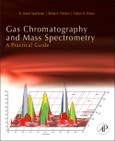The second edition of Gas Chromatography and Mass Spectrometry: A Practical Guide follows the highly successful first edition by F.G. Kitson, B.S. Larsen, and C.N. McEwen (1996), which was designed as an indispensible resource for GC/MS practitioners regardless of whether they are a novice or well experienced. The Fundamentals section has been extensively reworked from the original edition to give more depth of an understanding of the techniques and science involved with GC/MS. Even with this expansion, the original brevity and simple didactic style has been retained. Information on chromatographic peak deconvolution has been added along with a more in-depth understanding of the use of mass spectral databases in the identification of unknowns. Since the last edition, a number of advances in GC inlet systems and sample introduction techniques have occurred, and they are included in the new edition. Other updates include a discussion on fast GC and options for combining GC detectors with mass spectrometry.
The section regarding GC Conditions, Derivatization, and Mass Spectral Interpretation of Specific Compound Types has the same number of compound types as the original edition, but the information in each section has been expanded to not only explain some of the spectra but to also explain why certain fragmentations take place. The number of Appendices has been increased from 12 to 17. The Appendix on Atomic Masses and Isotope Abundances has been expanded to provide tools to aid in determination of elemental composition from isotope peak intensity ratios. An appendix with examples on "Steps to follow in the determination of elemental compositions based on isotope peak intensities" has been added. Appendices on whether to use GC/MS or LC/MS, third-party software for use in data analysis, list of information required in reporting GC/MS data, X+1 and X+2 peak relative intensities based on the number of atoms of carbon in an ion, and list of available EI mass spectral databases have been added. Others such as the ones on derivatization, isotope peak patterns for ions with Cl and/or Br, terms used in GC and in mass spectrometry, and tips on setting up, maintaining and troubleshooting a GC/MS system have all been expanded and updated.
Please Note: This is an On Demand product, delivery may take up to 11 working days after payment has been received.
Table of Contents
Preface Acknowledgments Section 1 THE FUNDAMENTALS OF GC/MS 1 Introduction and History 2 Gas Chromatography 3 The GC/MS Interface 4 Mass Spectrometry Instrumentation 5 Mass Spectral Data Interpretation 6 Quantitation with GC/MS Section 2 GC CONDITIONS, DERIVATIZATION, AND MASS SPECTRAL INTERPRETATION OF SPECIFIC COMPOUND TYPES 7 Acids 8 Alcohols 9 Aldehydes 10 Amides 11 Amines 12 Amino Acids 13 Common Contaminants 14 Drugs and Their Metabolites 15 Esters 16 Ethers 17 Fluorinated Compounds 18 Gases 19 Glycols 20 Halogenated Compounds (Other Than Fluorinated Compounds) 21 Hydrocarbons 22 Isocyanates 23 Ketones 24 Nitriles 25 Nitroaromatics 26 Nitrogen-Containing Heterocyclic Compounds 27 Nucleosides (TMS Derivatives) 28 Pesticides 29 Phenols 30 Phosphorus Compounds 31 Plasticizers and Other Polymer Additives (Including Phthalates) 32 Prostaglandins (MO-TMS Derivatives) 33 Solvents and Their Impurities 34 Steroids 35 Sugars (Monosaccharides) 36 Sulfur Compounds Section 3 APPENDICES Appendix A Definitions of Terms Related to Gas Chromatography Appendix B Definitions of Terms Related to Mass Spectrometry Appendix C Atomic Masses and Isotope Abundances and Other Information for the Determination of an Elemental Composition from Isotope Peak Intensity Ratios Appendix D X+1 and X+2 Values for Ions Containing Atoms of C and H Based on Isotope Contributions Appendix E Isotope Peak Patterns for Ions Containing Atoms of Cl and/or Br Appendix F Steps to Follow in the Determination of an Elemental Composition Based on Isotope Peak Intensity Ratios Appendix G Derivatization in GC/MS Appendix H Points of Comparison of LC/MS vs GC/MS Appendix I List of Available EI Mass Spectral Databases Appendix J Information Required for Reporting a GC/MS Analysis Appendix K Third-Party Software for Use with GC/MS Appendix L GC Installation and Maintenance Appendix M Troubleshooting Common GC Problems Appendix N Maintenance, Operating Tips, and Troubleshooting for Mass Spectrometers Appendix O Mixtures for Determining Mass Spectral Resolution Appendix P Cross-Index Chart for GC Stationary Phases Appendix Q Ions for Determining Unknown Structures Index








